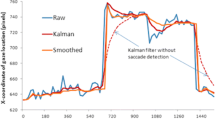Abstract
Aiming at the shortcomings of the existing methods which lead to low tracking accuracy, poor real-time performance and low tracking success rate, this paper proposes a method for learning progress tracking of multimedia port user based on improved CamShift algorithm. The infrared image is processed by multimedia technology, and the binary image is obtained. The initial pupil center position is obtained in the image. Finally, the eye tracking algorithm based on improved CamShift is used to further track the initial pupil center, and the learning progress tracking of multimedia port user is realized. The experimental results show that the average time consumed by the proposed method is 0.0065 s and the average number of iterations is 1.5. The real-time performance of the proposed method is the best, and the success rate of eye tracking is more than 80%. The overall performance of the proposed method is good.





Similar content being viewed by others
References
Cheng SW, Lu YH, Cai HG (2016) Mobile device eye tracking technology. Journal of Zhejiang University (Engineering Science) 50(2):1160–1166
Garry J, Casey K, Cole TK et al (2016) A pilot study of eye-tracking devices in intensive care. Surgery 159(3):938–944
Li WJ, Sun JY, Yao JG et al (2017) Segment tracking based multi-feature adaptive fusion target trackinga. Computer Simulation 34(5):337–341
Mi L, Lu S, Gang W et al (2016) Alleviated negative rather than positive attentional bias in patients with depression in remission: an eye-tracking study. J Int Med Res 44(5):1072–1086
Niefind F, Dimigen O (2016) Dissociating parafoveal preview benefit and parafovea-on-fovea effects during reading: a combined eye tracking and EEG study. Psychophysiology 53(6):1784–1798
Oberwelland E, Schilbach L, Barisic I et al (2016) Look into my eyes: investigating joint attention using interactive eye-tracking and fMRI in a developmental sample. Neuroimage 130(2):248–260
Oliveira D, Machín L, Deliza R et al (2016) Consumers’ attention to functional food labels: insights from eye-tracking and change detection in a case study with probiotic milk. LWT Food Sci Technol 68(1):160–167
Privitera CM, Sabesan R, Winter S et al (2016) Eye-tracking technology for real-time monitoring of transverse chromatic aberration. Opt Lett 41(8):1728–1731
Qin BZ (2017) Event-driven multi-agent moving target tracking algorithm. Automation & Instrumentation 39(4):35–37
Shi LY, Jiang BF, Wang H et al (2017) Comprehensive application of non-cooperative detection technology and electronic reconnaissance technology. Journal of China Academy of Electronics and Information Technology 12(2):383–388
Song ZJ, Wang N, Li AY et al (2017) The influence of emotion on the process of emergency information processing——based on eye tracking technology. J Intelligence 36(3):76–80
Stevenson SB, Sheehy CK, Roorda A (2016) Binocular eye tracking with the tracking scanning laser ophthalmoscope. Vis Res 118(15):98–104
Stuart S, Hunt D, Nell J et al (2018) Do you see what I see? Mobile eye-tracker contextual analysis and inter-rater reliability. Med Biol Eng Comput 56(2):289–296
Yang QH, Zhang DL, Xun Y et al (2016) Research on eye tracking method for human-computer interaction. Journal of Mechanical & Electrical Engineering 33(5):904–908
Yu YN, Chen J, Lv R et al (2016) Optimization Design of Multimedia Teaching Based on eye movement information analysis. Journal of Tianjin University of Technology and Education 26(8):50–53
Acknowledgments
This work is supported by Project of Jilin Development and Reform Commission (NO.2018C036-3).
Author information
Authors and Affiliations
Corresponding author
Additional information
Publisher’s note
Springer Nature remains neutral with regard to jurisdictional claims in published maps and institutional affiliations.
Rights and permissions
About this article
Cite this article
Sun, Hp., Wen, X. Research on learning progress tracking of multimedia port user based on improved CamShift algorithm. Multimed Tools Appl 80, 22719–22732 (2021). https://doi.org/10.1007/s11042-019-07761-4
Received:
Revised:
Accepted:
Published:
Issue Date:
DOI: https://doi.org/10.1007/s11042-019-07761-4




